Assessing Job Satisfaction in SMEs: Analysis, Measures, and Strategies
VerifiedAdded on 2021/04/16
|6
|1581
|93
Report
AI Summary
This analytical report assesses the quality of job satisfaction within a local SME, acknowledging the subjective nature of job satisfaction and the difficulties in measuring it. The report highlights the impact of job satisfaction on employee commitment and productivity. It proposes two critical measures: psychological factors (growth opportunities, recognition, and autonomy) and organizational factors (compensation, rewards, and performance management). The report emphasizes the importance of balancing these measures, drawing on Herzberg's two-factor theory, to create a committed workforce. Finally, the report recommends strategies such as fostering an organic culture, providing competitive compensation, and creating assessment centers to enhance employee job satisfaction. These strategies aim to improve employee engagement, performance, and loyalty through a comprehensive system-level approach.
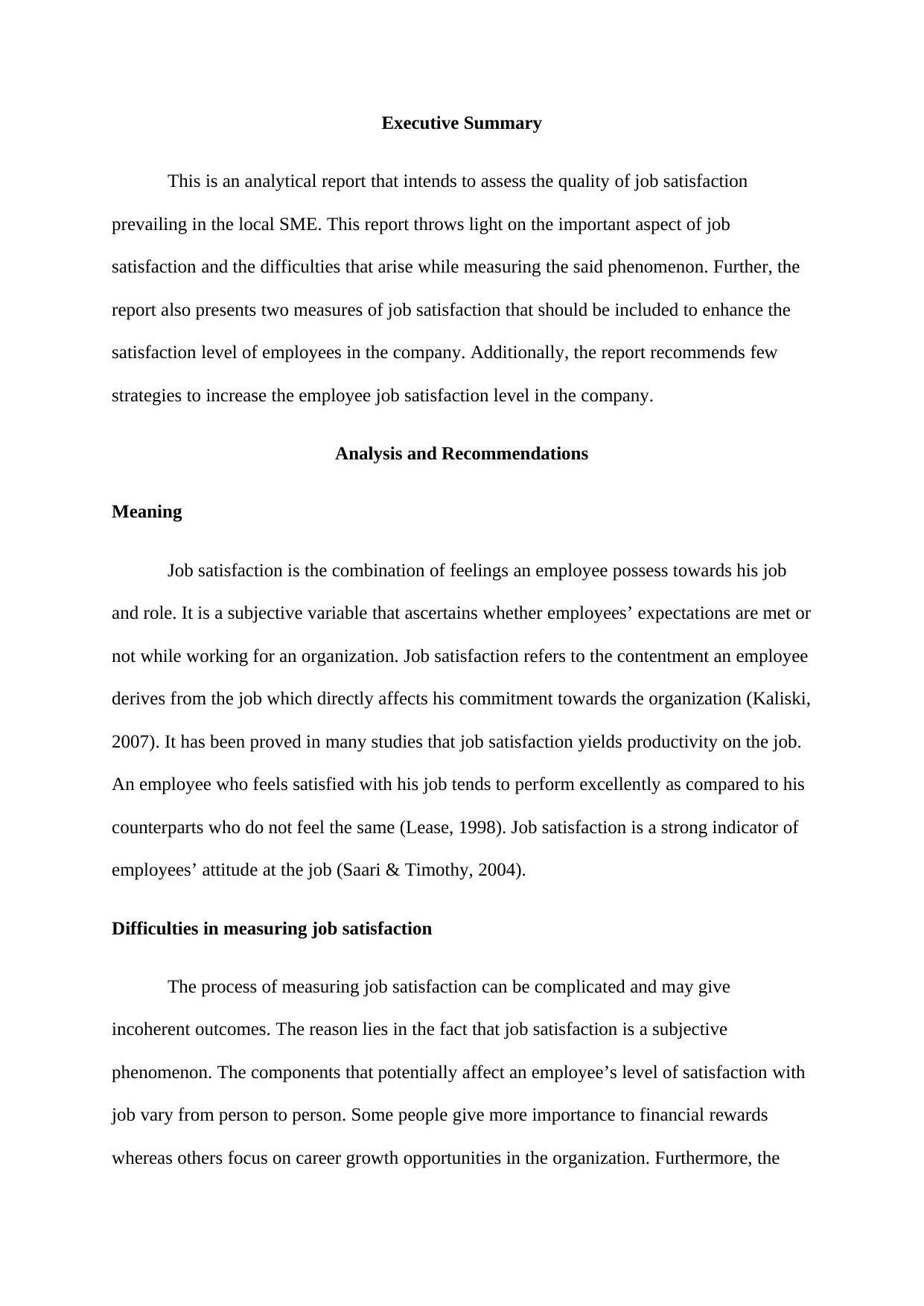
Executive Summary
This is an analytical report that intends to assess the quality of job satisfaction
prevailing in the local SME. This report throws light on the important aspect of job
satisfaction and the difficulties that arise while measuring the said phenomenon. Further, the
report also presents two measures of job satisfaction that should be included to enhance the
satisfaction level of employees in the company. Additionally, the report recommends few
strategies to increase the employee job satisfaction level in the company.
Analysis and Recommendations
Meaning
Job satisfaction is the combination of feelings an employee possess towards his job
and role. It is a subjective variable that ascertains whether employees’ expectations are met or
not while working for an organization. Job satisfaction refers to the contentment an employee
derives from the job which directly affects his commitment towards the organization (Kaliski,
2007). It has been proved in many studies that job satisfaction yields productivity on the job.
An employee who feels satisfied with his job tends to perform excellently as compared to his
counterparts who do not feel the same (Lease, 1998). Job satisfaction is a strong indicator of
employees’ attitude at the job (Saari & Timothy, 2004).
Difficulties in measuring job satisfaction
The process of measuring job satisfaction can be complicated and may give
incoherent outcomes. The reason lies in the fact that job satisfaction is a subjective
phenomenon. The components that potentially affect an employee’s level of satisfaction with
job vary from person to person. Some people give more importance to financial rewards
whereas others focus on career growth opportunities in the organization. Furthermore, the
This is an analytical report that intends to assess the quality of job satisfaction
prevailing in the local SME. This report throws light on the important aspect of job
satisfaction and the difficulties that arise while measuring the said phenomenon. Further, the
report also presents two measures of job satisfaction that should be included to enhance the
satisfaction level of employees in the company. Additionally, the report recommends few
strategies to increase the employee job satisfaction level in the company.
Analysis and Recommendations
Meaning
Job satisfaction is the combination of feelings an employee possess towards his job
and role. It is a subjective variable that ascertains whether employees’ expectations are met or
not while working for an organization. Job satisfaction refers to the contentment an employee
derives from the job which directly affects his commitment towards the organization (Kaliski,
2007). It has been proved in many studies that job satisfaction yields productivity on the job.
An employee who feels satisfied with his job tends to perform excellently as compared to his
counterparts who do not feel the same (Lease, 1998). Job satisfaction is a strong indicator of
employees’ attitude at the job (Saari & Timothy, 2004).
Difficulties in measuring job satisfaction
The process of measuring job satisfaction can be complicated and may give
incoherent outcomes. The reason lies in the fact that job satisfaction is a subjective
phenomenon. The components that potentially affect an employee’s level of satisfaction with
job vary from person to person. Some people give more importance to financial rewards
whereas others focus on career growth opportunities in the organization. Furthermore, the
Paraphrase This Document
Need a fresh take? Get an instant paraphrase of this document with our AI Paraphraser
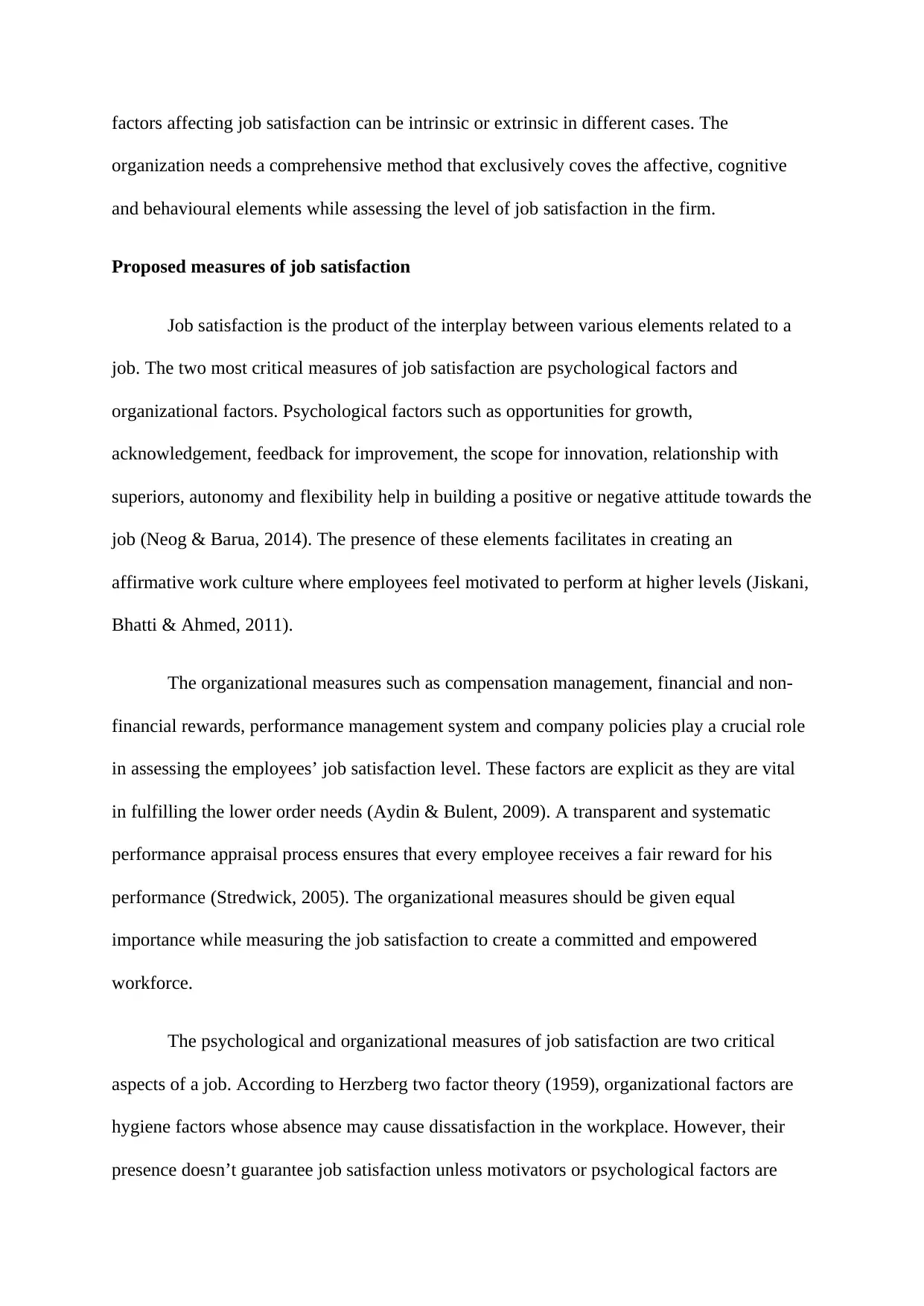
factors affecting job satisfaction can be intrinsic or extrinsic in different cases. The
organization needs a comprehensive method that exclusively coves the affective, cognitive
and behavioural elements while assessing the level of job satisfaction in the firm.
Proposed measures of job satisfaction
Job satisfaction is the product of the interplay between various elements related to a
job. The two most critical measures of job satisfaction are psychological factors and
organizational factors. Psychological factors such as opportunities for growth,
acknowledgement, feedback for improvement, the scope for innovation, relationship with
superiors, autonomy and flexibility help in building a positive or negative attitude towards the
job (Neog & Barua, 2014). The presence of these elements facilitates in creating an
affirmative work culture where employees feel motivated to perform at higher levels (Jiskani,
Bhatti & Ahmed, 2011).
The organizational measures such as compensation management, financial and non-
financial rewards, performance management system and company policies play a crucial role
in assessing the employees’ job satisfaction level. These factors are explicit as they are vital
in fulfilling the lower order needs (Aydin & Bulent, 2009). A transparent and systematic
performance appraisal process ensures that every employee receives a fair reward for his
performance (Stredwick, 2005). The organizational measures should be given equal
importance while measuring the job satisfaction to create a committed and empowered
workforce.
The psychological and organizational measures of job satisfaction are two critical
aspects of a job. According to Herzberg two factor theory (1959), organizational factors are
hygiene factors whose absence may cause dissatisfaction in the workplace. However, their
presence doesn’t guarantee job satisfaction unless motivators or psychological factors are
organization needs a comprehensive method that exclusively coves the affective, cognitive
and behavioural elements while assessing the level of job satisfaction in the firm.
Proposed measures of job satisfaction
Job satisfaction is the product of the interplay between various elements related to a
job. The two most critical measures of job satisfaction are psychological factors and
organizational factors. Psychological factors such as opportunities for growth,
acknowledgement, feedback for improvement, the scope for innovation, relationship with
superiors, autonomy and flexibility help in building a positive or negative attitude towards the
job (Neog & Barua, 2014). The presence of these elements facilitates in creating an
affirmative work culture where employees feel motivated to perform at higher levels (Jiskani,
Bhatti & Ahmed, 2011).
The organizational measures such as compensation management, financial and non-
financial rewards, performance management system and company policies play a crucial role
in assessing the employees’ job satisfaction level. These factors are explicit as they are vital
in fulfilling the lower order needs (Aydin & Bulent, 2009). A transparent and systematic
performance appraisal process ensures that every employee receives a fair reward for his
performance (Stredwick, 2005). The organizational measures should be given equal
importance while measuring the job satisfaction to create a committed and empowered
workforce.
The psychological and organizational measures of job satisfaction are two critical
aspects of a job. According to Herzberg two factor theory (1959), organizational factors are
hygiene factors whose absence may cause dissatisfaction in the workplace. However, their
presence doesn’t guarantee job satisfaction unless motivators or psychological factors are
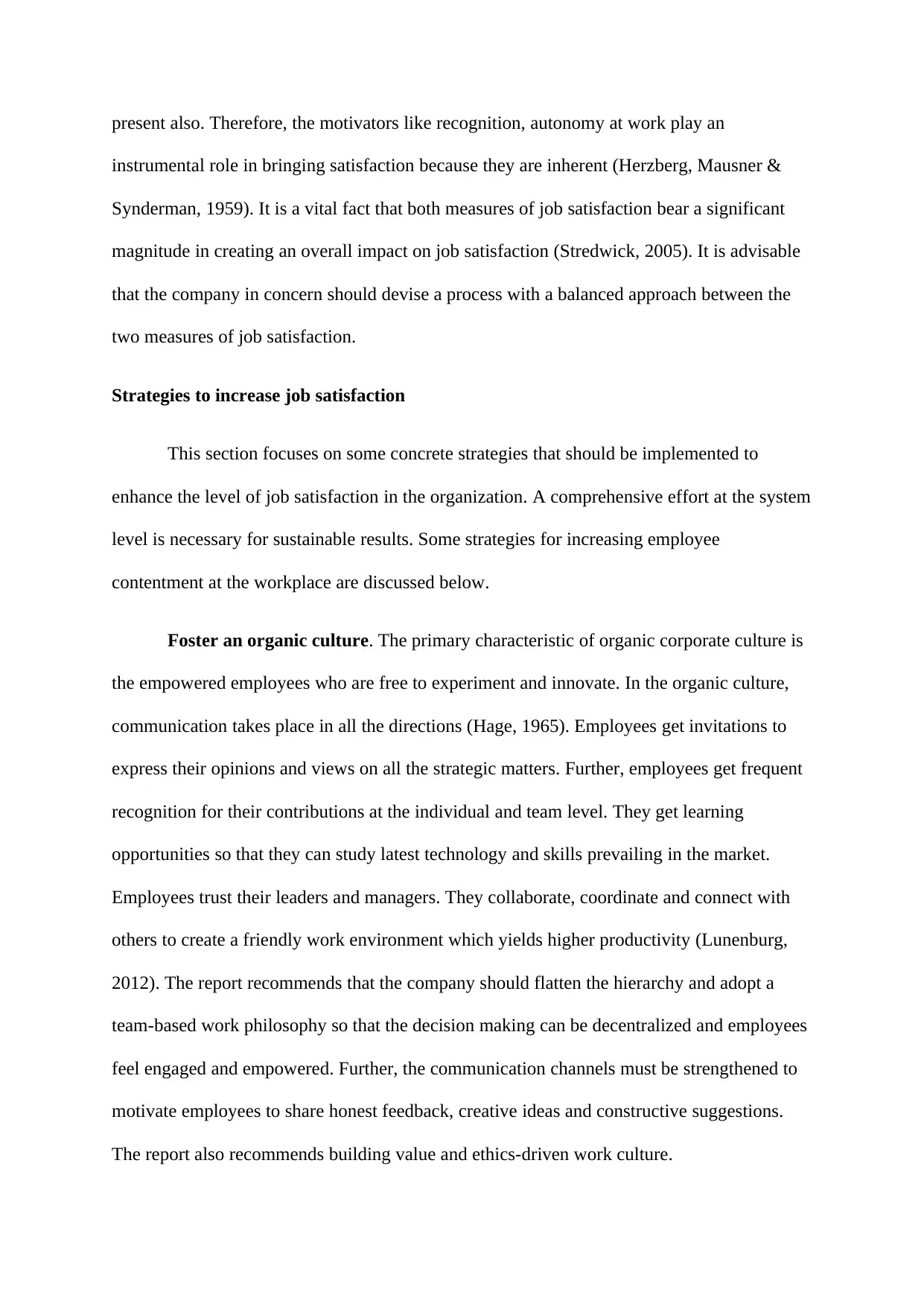
present also. Therefore, the motivators like recognition, autonomy at work play an
instrumental role in bringing satisfaction because they are inherent (Herzberg, Mausner &
Synderman, 1959). It is a vital fact that both measures of job satisfaction bear a significant
magnitude in creating an overall impact on job satisfaction (Stredwick, 2005). It is advisable
that the company in concern should devise a process with a balanced approach between the
two measures of job satisfaction.
Strategies to increase job satisfaction
This section focuses on some concrete strategies that should be implemented to
enhance the level of job satisfaction in the organization. A comprehensive effort at the system
level is necessary for sustainable results. Some strategies for increasing employee
contentment at the workplace are discussed below.
Foster an organic culture. The primary characteristic of organic corporate culture is
the empowered employees who are free to experiment and innovate. In the organic culture,
communication takes place in all the directions (Hage, 1965). Employees get invitations to
express their opinions and views on all the strategic matters. Further, employees get frequent
recognition for their contributions at the individual and team level. They get learning
opportunities so that they can study latest technology and skills prevailing in the market.
Employees trust their leaders and managers. They collaborate, coordinate and connect with
others to create a friendly work environment which yields higher productivity (Lunenburg,
2012). The report recommends that the company should flatten the hierarchy and adopt a
team-based work philosophy so that the decision making can be decentralized and employees
feel engaged and empowered. Further, the communication channels must be strengthened to
motivate employees to share honest feedback, creative ideas and constructive suggestions.
The report also recommends building value and ethics-driven work culture.
instrumental role in bringing satisfaction because they are inherent (Herzberg, Mausner &
Synderman, 1959). It is a vital fact that both measures of job satisfaction bear a significant
magnitude in creating an overall impact on job satisfaction (Stredwick, 2005). It is advisable
that the company in concern should devise a process with a balanced approach between the
two measures of job satisfaction.
Strategies to increase job satisfaction
This section focuses on some concrete strategies that should be implemented to
enhance the level of job satisfaction in the organization. A comprehensive effort at the system
level is necessary for sustainable results. Some strategies for increasing employee
contentment at the workplace are discussed below.
Foster an organic culture. The primary characteristic of organic corporate culture is
the empowered employees who are free to experiment and innovate. In the organic culture,
communication takes place in all the directions (Hage, 1965). Employees get invitations to
express their opinions and views on all the strategic matters. Further, employees get frequent
recognition for their contributions at the individual and team level. They get learning
opportunities so that they can study latest technology and skills prevailing in the market.
Employees trust their leaders and managers. They collaborate, coordinate and connect with
others to create a friendly work environment which yields higher productivity (Lunenburg,
2012). The report recommends that the company should flatten the hierarchy and adopt a
team-based work philosophy so that the decision making can be decentralized and employees
feel engaged and empowered. Further, the communication channels must be strengthened to
motivate employees to share honest feedback, creative ideas and constructive suggestions.
The report also recommends building value and ethics-driven work culture.
⊘ This is a preview!⊘
Do you want full access?
Subscribe today to unlock all pages.

Trusted by 1+ million students worldwide
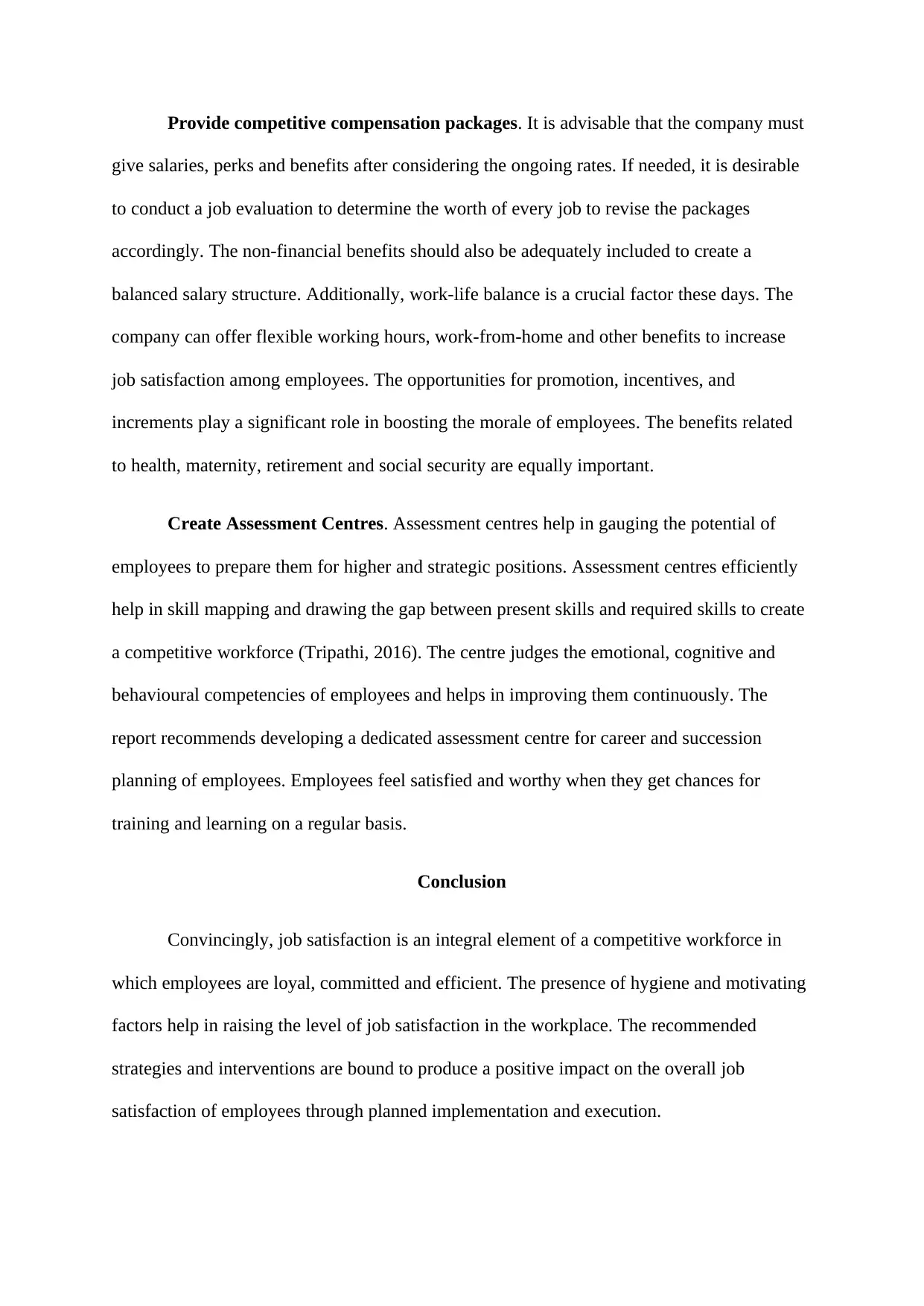
Provide competitive compensation packages. It is advisable that the company must
give salaries, perks and benefits after considering the ongoing rates. If needed, it is desirable
to conduct a job evaluation to determine the worth of every job to revise the packages
accordingly. The non-financial benefits should also be adequately included to create a
balanced salary structure. Additionally, work-life balance is a crucial factor these days. The
company can offer flexible working hours, work-from-home and other benefits to increase
job satisfaction among employees. The opportunities for promotion, incentives, and
increments play a significant role in boosting the morale of employees. The benefits related
to health, maternity, retirement and social security are equally important.
Create Assessment Centres. Assessment centres help in gauging the potential of
employees to prepare them for higher and strategic positions. Assessment centres efficiently
help in skill mapping and drawing the gap between present skills and required skills to create
a competitive workforce (Tripathi, 2016). The centre judges the emotional, cognitive and
behavioural competencies of employees and helps in improving them continuously. The
report recommends developing a dedicated assessment centre for career and succession
planning of employees. Employees feel satisfied and worthy when they get chances for
training and learning on a regular basis.
Conclusion
Convincingly, job satisfaction is an integral element of a competitive workforce in
which employees are loyal, committed and efficient. The presence of hygiene and motivating
factors help in raising the level of job satisfaction in the workplace. The recommended
strategies and interventions are bound to produce a positive impact on the overall job
satisfaction of employees through planned implementation and execution.
give salaries, perks and benefits after considering the ongoing rates. If needed, it is desirable
to conduct a job evaluation to determine the worth of every job to revise the packages
accordingly. The non-financial benefits should also be adequately included to create a
balanced salary structure. Additionally, work-life balance is a crucial factor these days. The
company can offer flexible working hours, work-from-home and other benefits to increase
job satisfaction among employees. The opportunities for promotion, incentives, and
increments play a significant role in boosting the morale of employees. The benefits related
to health, maternity, retirement and social security are equally important.
Create Assessment Centres. Assessment centres help in gauging the potential of
employees to prepare them for higher and strategic positions. Assessment centres efficiently
help in skill mapping and drawing the gap between present skills and required skills to create
a competitive workforce (Tripathi, 2016). The centre judges the emotional, cognitive and
behavioural competencies of employees and helps in improving them continuously. The
report recommends developing a dedicated assessment centre for career and succession
planning of employees. Employees feel satisfied and worthy when they get chances for
training and learning on a regular basis.
Conclusion
Convincingly, job satisfaction is an integral element of a competitive workforce in
which employees are loyal, committed and efficient. The presence of hygiene and motivating
factors help in raising the level of job satisfaction in the workplace. The recommended
strategies and interventions are bound to produce a positive impact on the overall job
satisfaction of employees through planned implementation and execution.
Paraphrase This Document
Need a fresh take? Get an instant paraphrase of this document with our AI Paraphraser
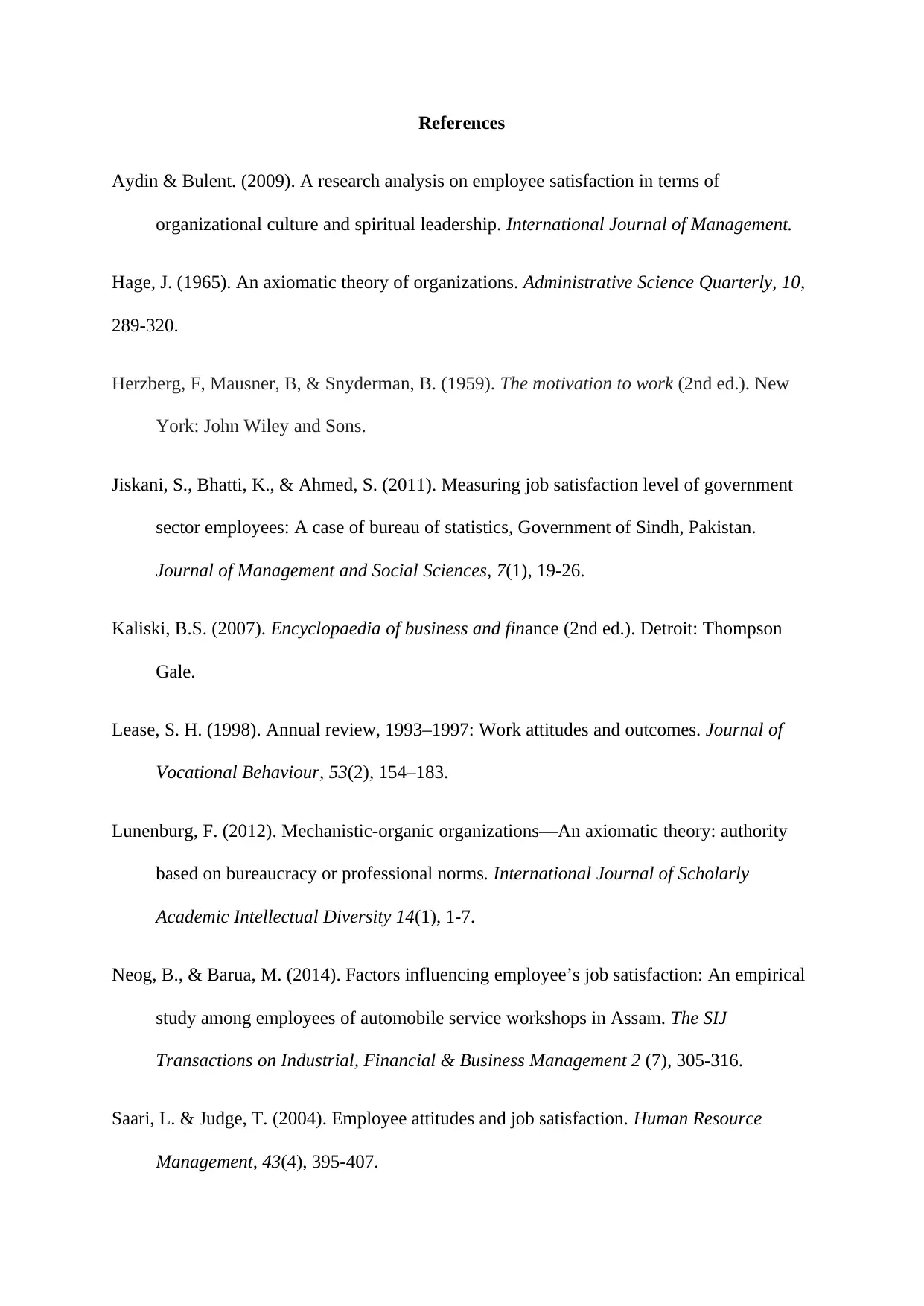
References
Aydin & Bulent. (2009). A research analysis on employee satisfaction in terms of
organizational culture and spiritual leadership. International Journal of Management.
Hage, J. (1965). An axiomatic theory of organizations. Administrative Science Quarterly, 10,
289-320.
Herzberg, F, Mausner, B, & Snyderman, B. (1959). The motivation to work (2nd ed.). New
York: John Wiley and Sons.
Jiskani, S., Bhatti, K., & Ahmed, S. (2011). Measuring job satisfaction level of government
sector employees: A case of bureau of statistics, Government of Sindh, Pakistan.
Journal of Management and Social Sciences, 7(1), 19-26.
Kaliski, B.S. (2007). Encyclopaedia of business and finance (2nd ed.). Detroit: Thompson
Gale.
Lease, S. H. (1998). Annual review, 1993–1997: Work attitudes and outcomes. Journal of
Vocational Behaviour, 53(2), 154–183.
Lunenburg, F. (2012). Mechanistic-organic organizations—An axiomatic theory: authority
based on bureaucracy or professional norms. International Journal of Scholarly
Academic Intellectual Diversity 14(1), 1-7.
Neog, B., & Barua, M. (2014). Factors influencing employee’s job satisfaction: An empirical
study among employees of automobile service workshops in Assam. The SIJ
Transactions on Industrial, Financial & Business Management 2 (7), 305-316.
Saari, L. & Judge, T. (2004). Employee attitudes and job satisfaction. Human Resource
Management, 43(4), 395-407.
Aydin & Bulent. (2009). A research analysis on employee satisfaction in terms of
organizational culture and spiritual leadership. International Journal of Management.
Hage, J. (1965). An axiomatic theory of organizations. Administrative Science Quarterly, 10,
289-320.
Herzberg, F, Mausner, B, & Snyderman, B. (1959). The motivation to work (2nd ed.). New
York: John Wiley and Sons.
Jiskani, S., Bhatti, K., & Ahmed, S. (2011). Measuring job satisfaction level of government
sector employees: A case of bureau of statistics, Government of Sindh, Pakistan.
Journal of Management and Social Sciences, 7(1), 19-26.
Kaliski, B.S. (2007). Encyclopaedia of business and finance (2nd ed.). Detroit: Thompson
Gale.
Lease, S. H. (1998). Annual review, 1993–1997: Work attitudes and outcomes. Journal of
Vocational Behaviour, 53(2), 154–183.
Lunenburg, F. (2012). Mechanistic-organic organizations—An axiomatic theory: authority
based on bureaucracy or professional norms. International Journal of Scholarly
Academic Intellectual Diversity 14(1), 1-7.
Neog, B., & Barua, M. (2014). Factors influencing employee’s job satisfaction: An empirical
study among employees of automobile service workshops in Assam. The SIJ
Transactions on Industrial, Financial & Business Management 2 (7), 305-316.
Saari, L. & Judge, T. (2004). Employee attitudes and job satisfaction. Human Resource
Management, 43(4), 395-407.

Stredwick, J. (2005). Introduction to human resource management, 2nd ed., Burlington:
Elsevier Butterworth Heinemann.
Tripathi, R. (2016). Assessment centres: benefits and shortcomings. Emerging Research in
Management &Technology, 5(2), 1-34.
Elsevier Butterworth Heinemann.
Tripathi, R. (2016). Assessment centres: benefits and shortcomings. Emerging Research in
Management &Technology, 5(2), 1-34.
⊘ This is a preview!⊘
Do you want full access?
Subscribe today to unlock all pages.

Trusted by 1+ million students worldwide
1 out of 6
Related Documents
Your All-in-One AI-Powered Toolkit for Academic Success.
+13062052269
info@desklib.com
Available 24*7 on WhatsApp / Email
![[object Object]](/_next/static/media/star-bottom.7253800d.svg)
Unlock your academic potential
Copyright © 2020–2025 A2Z Services. All Rights Reserved. Developed and managed by ZUCOL.





